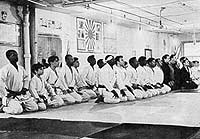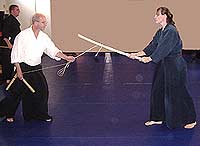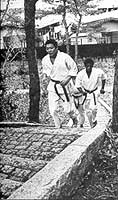From:
http://www.fightingarts.com/reading/article.php?id=402
By Dave Lowery
What does it mean to join a dojo (training hall) today in the traditional
sense, and what was it like to enter the dojo of a ryu (system) during
the feudal era? The similarities and differences of these ways are an
accurate reflection of the similarities and differences between the classical
bujutsu (military arts) and their successors, the budo (military way)
of our century.
 |
It takes more than a flash of
the cash and sporadic attendance to succeed in traditional dojo.
The students above are considered worthy and dedicated by their
instructor.
|
To no traditionalists, there might not be anything special about joining
a dojo. From their point of view you just walk in and make your wishes
known to whoever is in charge. Flash your MasterCard, sign a liability
waiver and you're a member of the club. However, this is a long way from
the manner in which things are done in a strictly traditional dojo and
it's light years away from the way the feudal warrior entered a dojo
in old Japan.
Understand first that the idea of the dojo or ryu as a
business began very recently. The ryu was anciently seen as a combination
of an extended
family, an intense and lengthy apprenticeship program, and often as
a semi-religious order.
There were exceptions, but the average ryu was relatively small. Whether
it was supported by a feudal lord or maintained privately, money was
rarely a consideration for the top instructors of the style. A select
group of faithful students or a benefactor were all that was necessary.
When the head instructor was retained by his lord, a stipend supported
him, the same way all the lord's other samurai were kept. Otherwise,
the headmaster depended on gifts and offerings from his disciples. Either
way, few instructors relied upon their teaching for their livelihood.
 The martial skills of classsical Japanese Ryu are still practiced
in Japan as well as abroad. Students share the unique experience
of practicing together an art inherited from Samurai times. Here
the author uses a chain and sickle (Isshin-ryu Kugarigama Jutsu)
against a sword held by Diane Skoss. This art is practiced as an
affiliated school (Fuzoko Ryuha) to Shindo Muso Ryu Jodo, a classical
school of jo (short stick). In Shindo Muso Ryu, the jo is used to
defend against the Japanese sword. (Photo courtesy of Christopher
Caile)
|
Early ryu had little use for large numbers of students, expensive fees
for training, or for professional instructors. How, then, did the prospective
disciple enter the ryu's dojo? Mainly by persistence. Initially, the
applicant had to approach the dojo with letters of introduction and recommendation
from someone known and respected by the masters of the ryu. This was
generally followed by a check into the applicant's background.
Records
were plentiful in old Japan and background checks weren't very difficult.
During the long Tokugawa regime, a thorough and far-reaching
network of intelligence agents was maintained by the government, and
laws made sure no one traveled outside his native province without
identification papers.
Records were plentiful in old Japan and background checks weren't very
difficult. During the long Tokugawa regime, a thorough and far-reaching
network of intelligence agents was maintained by the government, and
laws made sure no one traveled outside his native province without identification
papers.
Furthermore, for those of the warrior class, last name and home fief
established a lot about character and personal history. One reason for
this check was to insure that the applicant was of good character, but
another equally important consideration was to protect against the possibility
of a rival ryu member from slipping into an "enemy" school
to steal their secret techniques.
Once his background was ascertained, the applicant took the keppan (blood
oath), which was a written loyalty oath, signed or sealed with the applicant's
blood. The average classical warrioroften had a small scar on one of
his fingers, or inside his arm, from his encounter with the keppan. Practically
unnoticeable, it reminded him of the great honor it was to be a part
of his ryu.
Even after he became an official member of the ryu, the aspiring warrior's
application was still not complete. He was eligible only for a trial
period, usually referred to as te hodoki (unleashing of hands). It was
a probation that could be severe, one where the beginner was ordered
to perform all sorts of domestic chores-chopping wood, preparing meals,
washing uniforms; the kind of scenario that's popular in martial arts
movies to establish the tenacity of the film's future hero. It was a
test to see how much he'd tolerate. It ascertained how badly he wanted
to learn. If the beginner performed his assigned tasks with patience
and dignity he was soon accepted into the beginning ranks of the ryu.
He became a monjin (a person at the gate) of the ryu's teachings.
 |
Rigorous training such as running stairs, closely resembles the
karate training of early ryu.
|
Ancient students felt like they belonged, a feeling that carries over
into present-day Japan, where the individual is judged (and often judges
himself) according to the groups to which he belongs
The members of the ryu very much have the feeling of nakama (within
the interior space) with others of their school or style. They have shared
similar training, totally unique to those outside it.
They have a common understanding of the ryu. It's much like a family.
It's obvious, then, that joining a ryu meant more than just attending
lessons and learning skills. Even today, when a Japanese craftsman wishes
to convey the scope of his training, he sometimes uses the expression, "I
shared the mat with So-and-So Sensei." To share the mat or sit on
the mat with a high-ranked sensei has a particular significance. It means
the secrets and skills of his art have been passed directly down to the
speaker. He is the inheritor of the master's particular way of doing
the craft.
A lot of the budo customs have changed over the years? but they haven't
really been lost. True, there are no longer any keppan (blood) oaths,
and only a few schools practice anything like the period of probation.
But serious budoka respect the same bonds of belonging that their ancestors
did. Today's budoka feels (or should feel) that he's part of a very special
group, that he springs from a distinct and honorable lineage.
Students of a tradtional karate organaization, such as JKA, for example,
train in front of a portrait of Gichin Funakoshi, and they should derive
deep satisfaction knowing their teacher, or their teacher's teacher,
actually practiced karate under this great man.
Students of another karate style who visit a JKA dojo are lucky. And
students from the JKA who train in another system are equally fortunate.
But should they claim they are actually a part of the dojo they visit?
If they are willing to put on a white belt, forget their allegiance to
their original sensei and accept their adoptive style wholeheartedly,
the answer is yes. Otherwise, the visiting student who attempts to present
himself as a real member diminishes both himself and his teachers.
The entrance the modern-day budoka makes to his ryu or dojo may be simpler
than it was in the old days, but it has just as much meaning and commitment.
And if it is taken lightly or abused, if the student fails to understand
the implications of his passage to the door of the dojo, he can never
expect to proceed successfully beyond it.






 When
the conversation leads to the subject of toughness, as inevitably it
will among young men and women in transit on the Way, opinions will
flow liberally. This master, it will be recounted, knocked an opponent
senseless with the briefest riposte. That one, someone will say, uprooted
young trees with his bare hands. Still another will be said to crush
stalks of green bamboo with his bare hands. Comparative feats of strength
are presented as proof of toughness in these conversations, especially
those among younger bugeisha (a student of old style martial arts).
The more senior exponents, however, tend to have a different way of
measuring toughness
When
the conversation leads to the subject of toughness, as inevitably it
will among young men and women in transit on the Way, opinions will
flow liberally. This master, it will be recounted, knocked an opponent
senseless with the briefest riposte. That one, someone will say, uprooted
young trees with his bare hands. Still another will be said to crush
stalks of green bamboo with his bare hands. Comparative feats of strength
are presented as proof of toughness in these conversations, especially
those among younger bugeisha (a student of old style martial arts).
The more senior exponents, however, tend to have a different way of
measuring toughness
 The martial skills of classsical Japanese Ryu are still practiced
in Japan as well as abroad. Students share the unique experience
of practicing together an art inherited from Samurai times. Here
the author uses a chain and sickle (Isshin-ryu Kugarigama Jutsu)
against a sword held by Diane Skoss. This art is practiced as an
affiliated school (Fuzoko Ryuha) to Shindo Muso Ryu Jodo, a classical
school of jo (short stick). In Shindo Muso Ryu, the jo is used to
defend against the Japanese sword. (Photo courtesy of Christopher
Caile)
The martial skills of classsical Japanese Ryu are still practiced
in Japan as well as abroad. Students share the unique experience
of practicing together an art inherited from Samurai times. Here
the author uses a chain and sickle (Isshin-ryu Kugarigama Jutsu)
against a sword held by Diane Skoss. This art is practiced as an
affiliated school (Fuzoko Ryuha) to Shindo Muso Ryu Jodo, a classical
school of jo (short stick). In Shindo Muso Ryu, the jo is used to
defend against the Japanese sword. (Photo courtesy of Christopher
Caile)